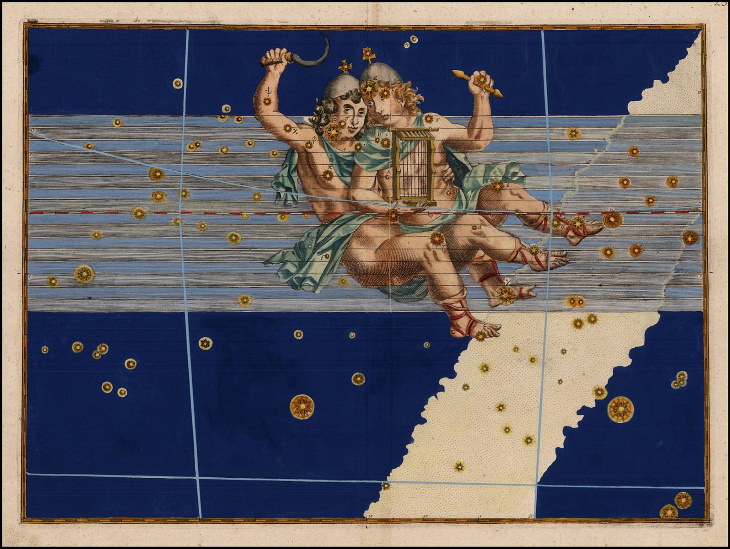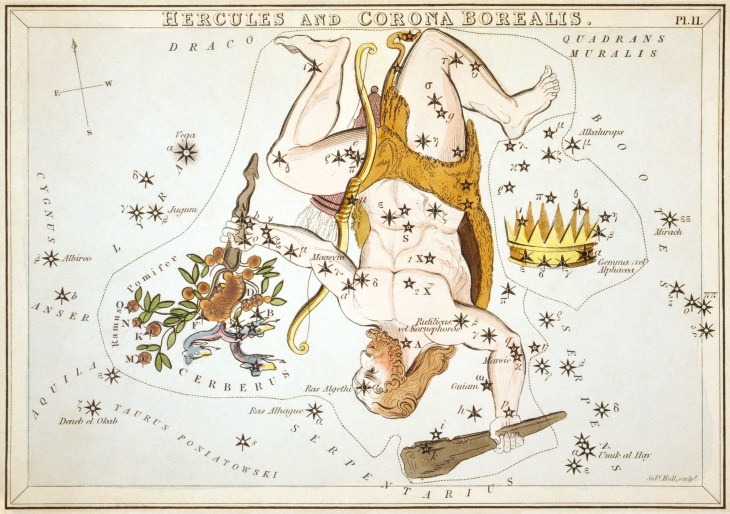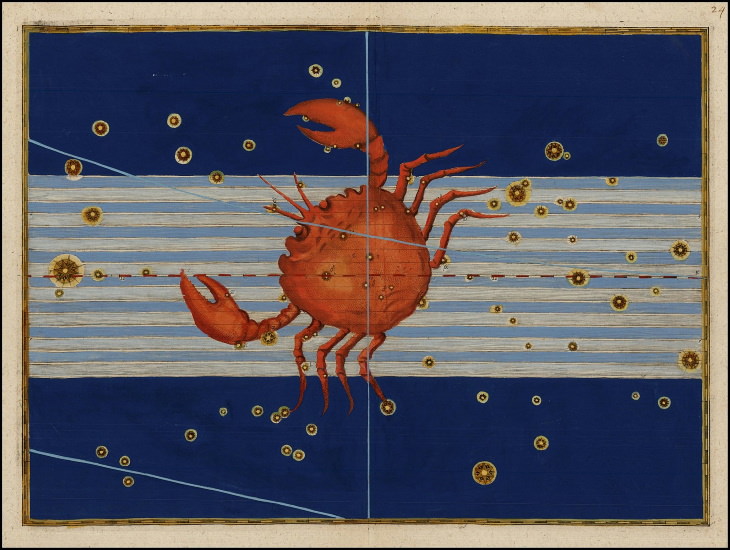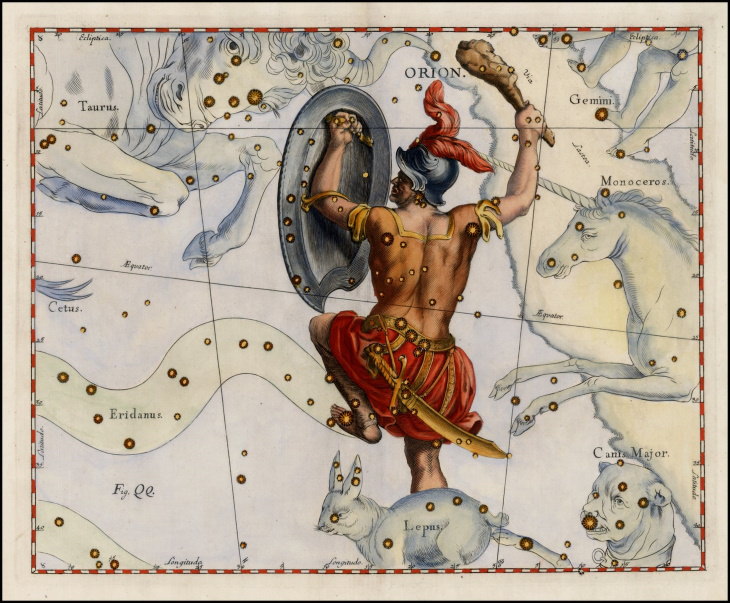1. Virgo
Virgo (Latin for “virgin”) is the second-largest constellation in the night sky, surpassed only by Hydra in its size. In the Northern Hemisphere, the constellation can be seen all night starting from late March to April, but it’s invisible from late autumn until the first weeks of spring. Because of its seasonal appearance, Ancient Greeks have closely associated this constellation with the harvest season.
The constellation itself is the depiction of Persephone, the goddess of both vegetation and the underworld. In Greek Mythology, the goddess’s fate is a tragic one. Young Persephone was the daughter of Demeter, the goddess of harvest and fertility. One day, Hades, the god of the dead, captured Persephone and took her away to the underworld to become his wife. Mourning the loss of her daughter, Demeter abandoned her duties, and the world turned into a barren wasteland. Seeing this, Zeus, the king of the gods, demanded his brother Hades return Persephone.
Hades agreed, but on one condition - Persephone had to abstain from eating any food in the underworld, or else, she would have to return to him for 4 months every year. The trickster he is, Hades then tricked naive Persephone into eating a pomegranate. This is how the Greeks explain the birth of seasons: when Persephone is reunited with her mother, spring arrives and everything starts to bloom, but when she returns to the underworld, winter takes over.
2. Cygnus
The night sky features many monsters and animals, too. Cygnus, the Swan, is one of them. Located in the Milky Way, Cygnus is one of the most prominent constellations in the Northern Hemisphere in summer and autumn. The constellation is also known as the Northern Cross. There are several myths behind this constellation. We will focus on the most prominent ones.
According to one myth, Zeus transformed himself into a wonderful swan to court Nemesis, the goddess of divine retribution, who transformed herself into a goose. The goddess soon delivered an egg and abandoned it. A shepherd stumbled upon the unusual egg and gave it to Leda, the queen of Sparta. When a baby, Helen of Troy, hatched from the egg, she was so beautiful that Leda decided to raise her as her own.
Cygnus depicts Zeus himself in the form of a swan. A parallel version of the myth states that Leda herself was seduced by Zeus, the swan, and from the brief relationship, two children - Polydeuces and Helen - were born.
3. Gemini
Gemini, or “the twins” from Latin, is not a particularly large constellation, but it is one of the constellations in the zodiac. The best time to view Gemini in the Northern Hemisphere is during February. The story of this constellation is linked to the myth of Cygnus.
Remember Polydeuces, one of the children of Leda and Zeus? Well, according to one myth, he had a twin brother, Castor, but his brother was not a half-god like him. Despite looking just like Polydeuces, Castor was a mortal - the son of Leda and her husband Tyndareus, the king of Sparta. The twins were born at the same time and grew up together, and they were very close.
Alas, Castor’s life was cut short when he was stabbed with a sword in a duel against another pair of twins. The immortal twin, Polydeuces, cried out to his father Zeus to share his gift of immortality with his breathless brother. Zeus agreed and moved both of them in the sky, where they became forever inseparable and known as the constellation Gemini.
4. Corona Borealis
A few inanimate objects were also commemorated as constellations. Corona Borealis, or The Northern Crown, is one such constellation. It is located right next to Heracles, the 5th largest constellation that depicts the legendary hero, Hercules.
Now, onto the story behind Corona Borealis. According to the myth, the crown belonged to Ariadne, the daughter of King Minos of Crete and the sister of the ferocious half-man, half-bull monster, the Minotaur. After slaying the Minotaur with Ariadne’s help, the hero Theseus promised to take the princess away with him. Theseus kept his word, but he ended up abandoning her on the island of Naxos.
Luckily for Ariadne, Dionysus, the god of wine, saved her and fell in love with her. As a token of his love and care, Dionysus took seven of the most beautiful jewels in the world and had it made into a crown for his queen. After her death, Zeus placed Ariadne’s Crown into the sky, replacing each of the jewels with seven stars.
5. Cancer
The Cancer constellation is also small and relatively dim, although it is part of the zodiac. Translated as “the crab” from Latin, Cancer is situated between Leo and Gemini. The zodiac sign looks like an upside-down Y, and it can be seen in the Northern Hemisphere in the early spring, and in the Southern Hemisphere in the fall.
The Cancer constellation represents the giant crab that was sent by Hera to kill Hercules while he was battling the Lernaean Hydra, a giant water serpent with many heads. In the myth, the crab attacks the hero, but Hercules smashes it with his club. This battle was the second of the 12 labors Hercules was ordered to perform to redeem himself for accidentally killing his family under Hera’s spell. Learn more about Hercules' story in the article 12 Captivating Constellations And How They Got Their Names.
6. Ursa Major and Ursa Minor
Ursa Major and the nearby Ursa Minor are among the most visible and famous constellations in the Northern Hemisphere. Although it can be seen year-round, the best time to view it is mid-spring. The names of the constellations are translated as “greater she-bear” and “lesser bear” accordingly.
Like many of the stories involving Ancient Greek deities, the myth of Ursa Major is a tragic one. According to the myth, Zeus started courting a beautiful nymph named Callisto. When his wife, Hera, heard about Zeus’ infatuation with Callisto, she turned her into a bear in a bout of jealousy. Poor Callisto wandered the forest in animal form for years.
One day, she met her son, Arcas, who didn’t recognize his mother and shot an arrow right through her heart. As a gesture of good faith, Zeus turned Callisto into Ursa Major and Arcas as Ursa Minor, where they will remain together as equals forever. If you were wondering why both Ursa Minor and Ursa Major have long tails, here's a curious explanation: according to the myth, Zeus threw both of the bears in the sky by holding them by their short tails, and he accidentally stretched them out.
7. Aquarius
Aquarius ("water-bearer" or "cupbearer" in Latin) is the last of the 12 zodiac constellations we will tell you about in this article. The constellation is situated near other water signs - Pisces, Delphinus, and Cetus - in the area of the sky known as the water section. It appears in the Northern Hemisphere in autumn (although it’s quite difficult to see it with the naked eye).
Discovered by Ptolemy, the famous Greek astronomer, in the 2nd century AD, Aquarius is one of the oldest known constellations. But who is Aquarius himself? According to lore, the constellation embodies Ganymede, a young mortal who was taken to Mount Olympus and given the gift of eternal youth by Zeus himself. Ganymede was the cupbearer of the Olympic gods, and for his service, Zeus depicted his image in the sky.
8. Orion
Orion, the hunter, is one of the most recognized and bright constellations in the sky. Orion’s Belt that consists of three of the brightest stars in the constellation - Alnilam, Mintaka, and Alnitak - can be easily found in the Northern Hemisphere in January with the naked eye. Orion is seen in the sky next to Taurus, the bull, fighting the beast with a club and shield.
According to myth, Orion was the son of Poseidon, the god of the ocean. He was an extraordinarily talented hunter and vowed he could kill all the animals on earth. Enraged by his hubris, Artemis, the goddess of the hunt and animals, sent a scorpion to murder the hunter and turned both fighters into constellations, ensuring that the fight would never end.
Curiously enough, the myth is consistent with actual astronomical observations - the Orion constellation vanishes from the sky at the exact same time the Scorpius constellation appears.
Share these stories with those who enjoy ancient history and mythology!








